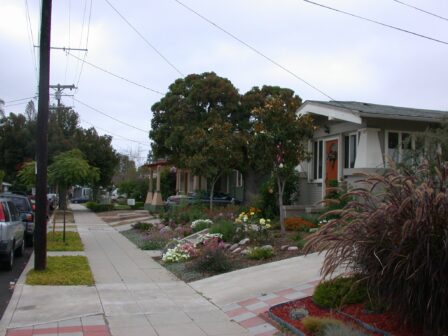Planning Regulations Affecting Mission Hills

A block of Falcon Street, south of University Avenue, that should be re-zoned to protect the single family homes.
by Barry E. Hager
There is good news on two fronts for Mission Hills’ residents: The Uptown Interim Height Ordinance (IHO) has been extended again and there has been progress on the Uptown community plan update. These developments will advance the goals to protect the character of Mission Hills.
Firstly, the San Diego City Council voted unanimously to extend the IHO last November. The IHO provides temporary building height limits of 50 feet in the commercial core area of Mission Hills (along Washington Street and Goldfinch) and 65 feet in Hillcrest, areas where 150 or 200 feet were allowed by existing zoning. The IHO was first enacted in 2008 to prevent taller projects from making an end-run around the community plan update. Extended twice, the IHO was slated to expire this past January if the City Council did not act. Fortunately, with the urging of community groups such as Mission Hills Heritage, the Mission Hills Town Council, the Hillcrest Town Council and many Uptown residents, the City moved the extension through the legislative process, and the extension was voted on before the ordinance expired. This time the extension is coterminous with completion of the community plan update, which means we will not have to lobby for another extension of the IHO!
The long-delayed update of the Uptown community plan has also begun to move forward again. The community plan serves as a blueprint for future development and was last updated in 1988. Last year, Mission Hills Heritage and the Mission Hills Town Council arrived at a joint set of land use recommendations for Mission Hills, which include redefining those areas designated for single family use, multi-family use and mixed commercial/residential use, and the dwelling density levels in those areas. These recommendations are designed to preserve many blocks of single family homes that had been previously zoned for multi-family (including the area south of University Avenue) and would help maintain the historic, lower scale of the commercial core area of Mission Hills. A positive sign emerged when the City released its first draft of the community plan update late last fall which included a planned land use map with our land use and density recommendations. This is a strong indication that the final plan will include our recommendations.
On the issue of permanent building height limits, Mission Hills Heritage submitted a set of recommendations to Uptown Planners this past January. The recommendations are for a 50-foot maximum in the commercial core of Mission Hills, with 35 feet in adjacent multi-family areas and 30 feet in adjacent single family areas. Uptown Planners voted to endorse these recommendations, which increases the likelihood that such will be included in the City’s next draft of the community plan, due to be released this April.
All of this is good news for those that cherish the historic character of our neighborhood. There are many other important aspects of the community plan, but land use rules and building heights are two key areas that influence the character and appearance of our neighborhood. Convincing the City to include our recommendations in the community plan update has been a longstanding goal of Mission Hills Heritage. However, including our recommendations in the City’s draft of the community plan still does not assure that they will be included in the final community plan. The decisive battle will take place during the approval process at City Council, sometime in the next two years.
____________________________________________________________________________
Barry Hager is a board member of Mission Hills Heritage and has lived with his family in Mission Hills for fifteen years.
Category: Local News







